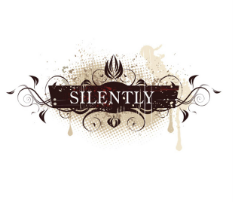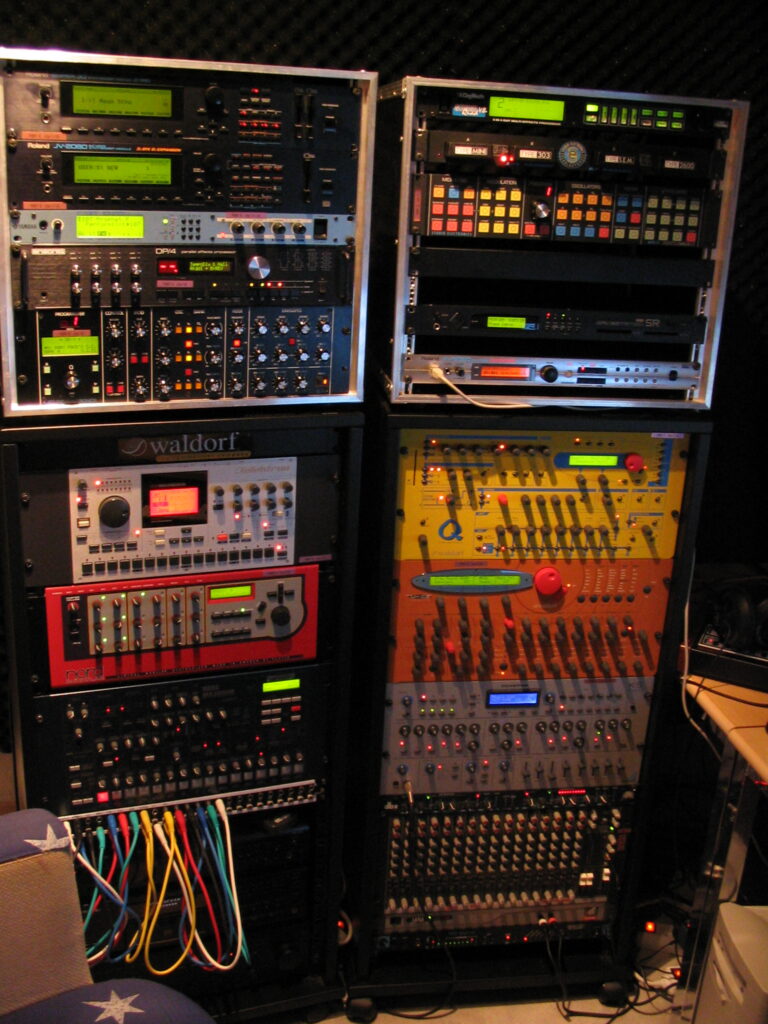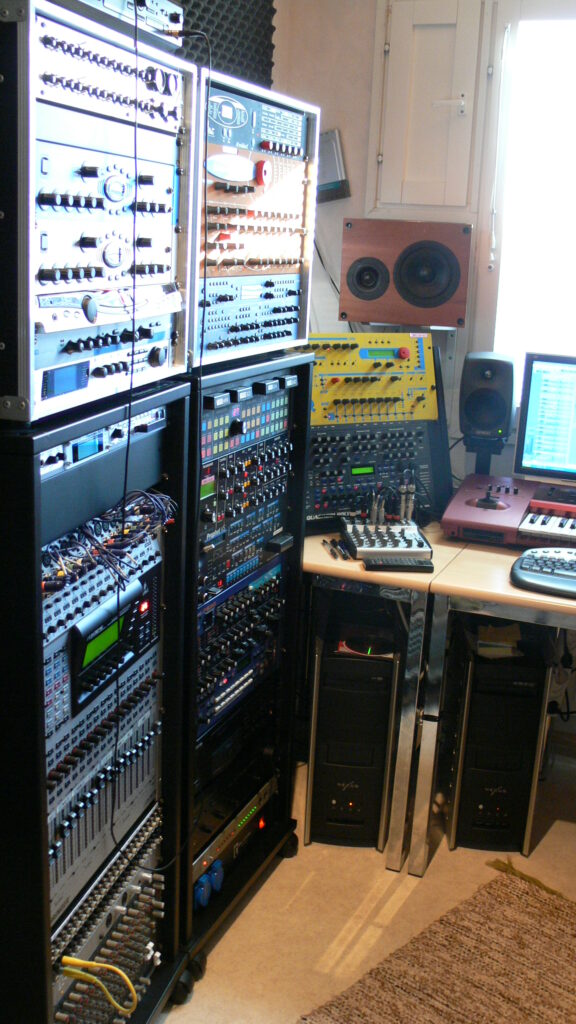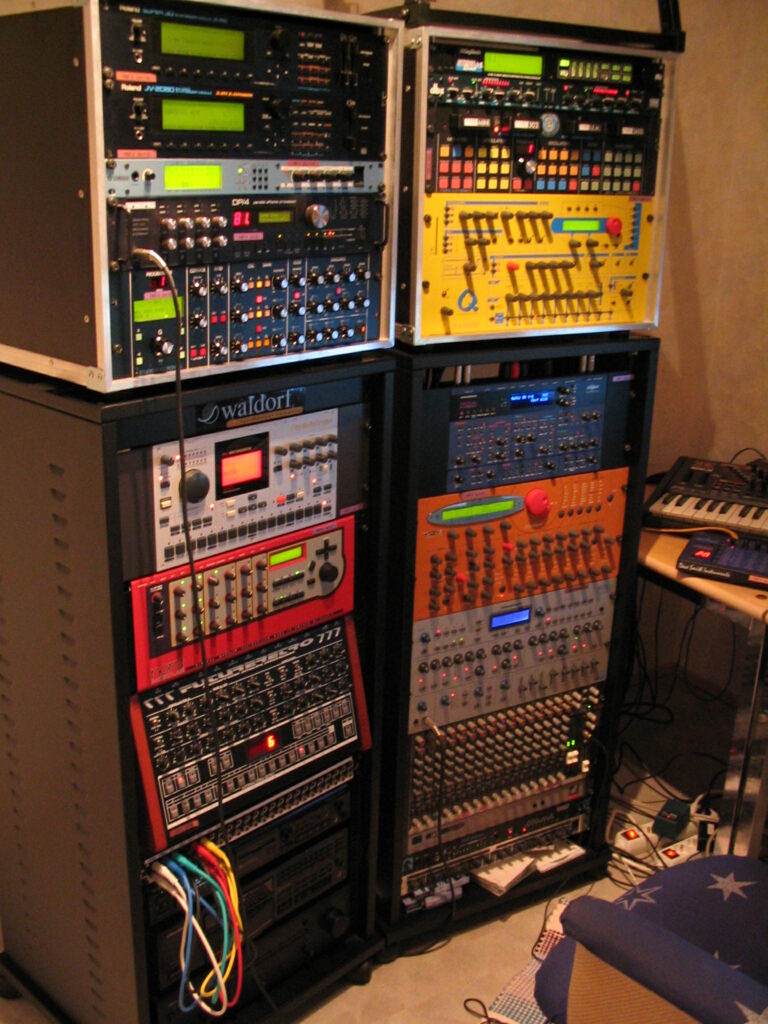
Genre: Electro, ambient, drum’n bass
Year of release: 2007
Cover: Matias Hakunti
Mastering: Pete Lämsä
Spotify link
Main gear:
Clavia Nord Modular G1 Rack
Dave Smith Instruments Evolver
Elektron Machinedrum
Future Retro 777
Korg Karma
Novation KS-Rack
Novation Supernova 2 Rack
Roland Fantom XR
Roland JD-800 / JD-990 (vintage expansion)
Roland JP-8080
Roland JV-2080 (several expansions)
Roland XV-3080
Studio Electronics ATC-1 (all four filters)
Studio Electronics SE-1
Yamaha AN1x
Waldorf Microwave XT
Waldorf Pulse
Waldorf Q
Behringer V-Verb x2
DBX 166XL
Lexicon MPX-100
Behringer UB1002
Behringer DDX3216
Mackie LM3204
Soundcraft Spirit Studio 16
AKG Studio 271
Genelec 8020
Hifi 12/2 passive
Klein+Hummel O110
Sony MD
Yamaha AX-440
Cakewalk 9
Nemesys Gigastudio 3 and NI Kontakt for sampling
Sound Forge 4
This album was originally released under the name of DeadZone Music. Tracks were made during 2003 – 2006.
At the beginning of the year 2000 Drum’n Bass became more and more popular. DeadZone Music had one of the most popular (100 000’s of downloads) tracks in download.com under atmospheric drum’n’bass genre. Only a few bands like Amon Tobin and Pendulum were higher in the drum’n’bass charts, which was the upper genre of atmospheric d’n’b. Unfortunately download.com was bought and the music site was closed down. All tracks have been used in various video productions. The track Starcycle made it to the final of mikseri.net “Greatest Bits” competition and some other tracks to Space Junk (YLE) and Bassoradio radio shows.
At that time I was only using hardware, so the technical level was higher, it was very time-consuming. I used Sony Minidisc to record not only sketches and ideas, but also the final track via S/PDIF connection. Then I recorded it digitally back to the computer. This way I could listen to the ideas whenever I wanted without having to start the computer. I tried to minimise computer use and problems, but also to make things smoother when creating ideas. For the same reason I tried to avoid old analogue synthesizers: I wanted to make music, not deal with technical problems and tuning issues. I did everything with MIDI: played, quantized and recorded CC/sysex. There are a few drum loops in some tracks, but the beats were mostly made by playing or by hand. When the track was ready, I recorded MIDI to audio from a Behringer DDX3216 digital mixer to Minidisc. Then I transferred it digitally back to the computer and did the final touches.
At that time I was in contact with Pete Lämsä who had Genelec 1029 and 1032 monitors and also TC Electronic Finalizer. So he made the final master. An old classmate from the Kokkola days, Matias Hakunti, did the covers.
On the gear side, my equipment changed a bit during those years. My go-to synths were Elektron Machinedrum, Novation Supernova 2 Rack, Roland JV-2080/XV-3080/Fantom XR, Studio Electronics ATC-1x/SE-1, Yamaha AN1x and Waldorf Q.
Elektron Machinedrum was more of a drum synth than a normal drum machine. The presets weren’t very good, so it needed some tweaking. I was lucky enough to win it in a Sonicstate competition. It was probably the first machine drum in Finland. Like the Supernova 2, it had audio inputs, which I used for some synths. Most of the drums came from Gigasampler and Machinedrum. Machinedrum also did some rhythmic fx (e.g. track: Closed Reality).
In the 90’s I had Nova and Supernova 2 was better in many ways and still had the same type of sound I liked. The presets were really bad so you had to make your own. I used it for many things like distorted synths, midrange bass/synth lines even some pads. E.g. Future Retro 777 went through SN2 effects, so it was also a good FX box.
Roland gear was used for a lot of sounds. Expansion cards had really useful stuff like pads. I also knew them very well as I had JV-1010 and JV-1080 in the 90s. JV-1080 was actually the best sounding of them all IMO, but the MIDI control was the worst. I could control JV-2080 and newer units with Yamaha AN1x. They had the same MIDI mapping so I could control the most important things like envelopes and filters with the AN1x knobs.
Studio Electronics ATC-1 and SE-1 did most of the bass work. There was also Evolver (track: Inside) and some mid/TB stuff from 777 (tracks: Inside, Closed Reality).
The Yamaha AN1x was the master keyboard and I had had it since -97 so I knew it well. It was pretty easy to edit once you got into the editing matrix. The modulation matrix was good too. The keyboard feel and aftertouch response was good for my needs. I tried several other keyboards but kept coming back to the AN1x. Soundwise it was quite difficult to fit into the mix, the sweet spot was narrow in my experience. You had to be careful with the FX and filters. Still, I have used it on most if not all of my tracks since 1997.
Waldorf Q was head above Micro Q, which I had since the early 2000s. Tone was better, probably because of the higher DSP power and maybe better converters, but it also had its own fx per part. It was used for many types of sounds: pads, sequences, fx. I never really got great bass and lead sounds out of it. It was like the Roland synths: it didn’t sound great on its own, but it was very good in the mix.
There are only a few digipak albums left. Contact me to get one.





